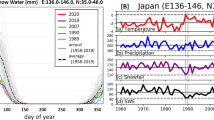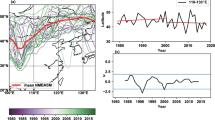Abstract
This study investigates future changes in the accumulated and daily heavy winter snowfall in central Japan and the surrounding regions. We analyze outputs of the 48-member ensemble regional climate simulations in the historical and future climates. In the historical climate simulations, each ensemble member has a 61-year simulation from September 1950 to August 2011. For the future climate simulations, we also conduct 61-year simulations assuming the climate at the end of the twenty-first century (2080–2099) when the global mean surface air temperature is about 4 °C warmer than the pre-industrial climate (1861–1880) as projected under the Representative Concentration Pathway (RCP) 8.5 scenario. Our simulations show that the heavy snowfall occurring at a frequency of every 10 years is enhanced in the inland areas of the central part of the Japanese archipelago (central Japan) where the total winter snowfall amount decreases significantly. Heavy snowfall is also intensified in the northern part of the Asian continent where the surface air temperature is much colder than over central Japan. A composite analysis of heavy snowfall events in central Japan indicates that such events occur when the Japan Sea polar air mass convergence zone (JPCZ) appears during the East Asian winter monsoon season. In the future climate projections, the JPCZ is intensified since the warm ocean supplies more moisture due to warming. An upward wind anomaly is also found over the windward side of mountains where the upward flow is prevalent climatologically. The intensification of both the JPCZ and the upward wind over the mountain ranges result in the enhancement of heavy snowfall in inland areas where the surface air temperature is still below 0 °C.





Similar content being viewed by others
References
Armstrong RL, Brun E (eds) (2008) Snow and climate: physical processes, surface energy exchange and modeling. Cambridge University Press, Cambridge, 222 pp
Brown RD, Mote P (2009) The response of Northern Hemisphere snow cover to a changing climate. J Clim 22:2124–2145
Burnett AW, Kirby ME, Mullins HT, Patterson WP (2003) Increasing Great Lake-effect snowfall during the twentieth century: a regional response to global warming? J Clim 16:3535–3542
Collins M, Knutti R, Arblaster J, et al. (2013) Long-term climate change: projections, commitments and irreversibility. In: Stocker TF et al. (eds) Climate Change 2013: The Physical Science Basis, Contribution of Working Group I to the Fifth Assessment Report of the Intergovernmental Panel on Climate Change, chap. 12. Cambridge Univ. Press, Cambridge
de Vries H, Lenderink G, van Meijgaard E (2014) Future snowfall in western and central Europe projected with a high-resolution regional climate model ensemble. Geophys Res Lett 41:4294–4299. doi:10.1002/2014GL059724
Gula J, Peltier RW (2012) Dynamical downscaling over the Great Lakes basin of North America using the WRF regional climate model: the impact of the Great Lakes system on regional greenhouse warming. J Clim 25:7723–7742
Heo KY, Ha KJ (2008) Snowstorm over the southwestern coast of the Korean Peninsula associated with the development of mesocyclone over the Yellow Sea. Adv Atmos Sci 25(5):765–777. doi:10.1007/s00376-008-0765-2
Hirahara S, Ishii M, Fukuda Y (2014) Centennial-Scale Sea surface temperature analysis and its uncertainty. J Clim 27:57–75. doi:10.1175/JCLI-D-12-00837.1
Hjelmfelt MR (1990) Numerical study of the influence of environmental conditions on lake-effect snowstorms over Lake Michigan. Mon Weather Rev 118:138–150
Ishizaki NN, Takayabu I, Oh’izumi M, et al. (2012) Improved performance of simulated Japanese climate with a multi-model ensemble. J Meteorol Soc Jpn 90:235–254
Kawase H, Hara M, Yoshikane T, et al. (2013) Altitude dependence of future snow cover changes over Central Japan evaluated by a regional climate model. J Geophys Res 118:12444–12457. doi:10.1002/2013JD020429
Kawase H, Suzuki C, Ishizaki NN, et al. (2015a) Simulations of monthly variation in snowfall over complicated mountainous areas around Japan’s Northern Alps. SOLA 11:138–143. doi:10.2151/sola.2015-032
Kawase H, Sasaki H, Murata A, et al. (2015b) Future changes in winter precipitation around Japan projected by ensemble experiments using NHRCM. J Meteorol Soc Jpn 93:571–580. doi:10.2151/jmsj.2015-034
Lim K-S, Hong S-Y (2007) Numerical simulation of heavy snowfall over the Ho-Nam province of Korea in December 2005. J Korean Meteorol Soc 43:161–173
Lute AC, Abatzoglou JT, Hegewisch KC (2015) Projected changes in snowfall extremes and interannual variability of snowfall in the western United States. Water Resour Res 51:960.972. doi:10.1002/2014WR016267
Ma X, Yoshikane T, Hara M, et al. (2010) Hydrological response to future climate change in the Agano River basin, Japan. Hydrol Res Lett 4:25–29
Manabe S (1957) On the modification of air-mass over the Japan Sea when the outburst of cold air predominates. J Meteorol Soc Jpn 35:311–326
Mizuta R, Yoshimura H, Murakami H, et al. (2012) Climate simulations using MRI-AGCM with 20-km grid. J Meteorol Soc Jpn 90(A):233–258
Mizuta R, Arakawa O, Ose T, et al. (2014) Classification of CMIP5 future climate responses by the tropical sea surface temperature changes. SOLA 10:167–171. doi:10.2151/sola.2014-035
Nagata M, Ikawa M, Yoshizumi S, Yoshida T (1986) On the formation of a convergent cloud band over the Japan Sea in winter; numerical experiments. J Meteorol Soc Jpn 64:841–855
Notaro M, Bennington V, Vavrus S (2015) Dynamically downscaled projections of lake-effect snow in the Great Lakes basin. J Clim 28:1661–1684. doi:10.1175/JCLI-D-14-00467.1
O’Gorman PA (2014) Contrasting responses of mean and extreme snowfall to climate change. Nature 512(7515):416–418
Peace RL, Sykes RB Jr. (1966) Mesoscale study of a lake-effect snowstorm. Mon Weather Rev 94(8):495–507
Räisänen J, Eklund J (2012) Twenty-first century changes in snow climate in northern Europe: A high-resolution view from ENSEMBLES regional climate models. Clim Dyn 38:2575–2591. doi:10.1007/s00382-011-1076-3
Rasmussen R, Liu C, Ikeda K, et al. (2011) High-resolution coupled climate runoff simulations of seasonal snowfall over Colorado: a process study of current and warmer climate. J Clim 24:3015–3048
Sasaki H, Kurihara K, Takayabu I, Uchiyama T (2008) Preliminary experiments of reproducing the present climate using the non-hydrostatic regional climate model. SOLA 4:25–28. doi:10.2151/sola.2008-007
Shi X, Durran DR (2015) Estimating the response of extreme precipitation over midlatitude mountains to global warming. J Clim 28(10):4246–4262
Siler N, Roe G (2014) How will orographic precipitation respond to surface warming? An idealized thermodynamic perspective. Geophys Res Lett 41. doi:10.1002/2013GL059095
Steenburgh WJ, Halvorson SF, Onton DJ (2000) Climatology of lake-effect snowstorms of the Great Salt Lake. Mon Weather Rev 128:709–727
Steger C, Kotlarski S, Jonas T, Schär C (2012) Alpine snow cover in a changing climate: a regional climate model perspective. Clim Dyn 41:735–754. doi:10.1007/s00382-012-1545-3
Steiger SM, Schrom R, Stamm A, et al. (2013) Circulations, bounded weak echo regions, and horizontal vortices observed within long-lake-axis-parallel-lake-effect storms by the Doppler on wheels. Mon Weather Rev 141(8):2821–2840
Sun J, Wang H, Yuan W, Chen H (2010) Spatial-temporal features of intense snowfall events in China and their possible change. J Geophys Res 115:D16110. doi:10.1029/2009JD013541
Vaughan DG, Comiso JC, Allison I, et al. (2013) Observations: cryosphere. In: Stocker TF et al. (eds) Climate Change 2013: The Physical Science Basis, Contribution of Working Group I to the Fifth Assessment Report of the Intergovernmental Panel on Climate Change, chap. 4. Cambridge Univ. Press, Cambridge
Wi S, Dominguez F, Durcik M, Valdes J, et al. (2012) Climate change projection of snowfall in the Colorado River Basin using dynamical downscaling. Water Resour Res 48:W05504. doi:10.1029/2011WR010674
Acknowledgments
We thank all members of MRI, AORI, NIES, DPRI, JAMSTEC, and the University of Tsukuba, who built up d4PDF. The Earth Simulator was used in this study as a “Strategic Project with Special Support” of JAMSTEC. Also, the study was supported by the Program for Risk Information on Climate Change (SOUSEI) and the Data Integration and Analysis System (DIAS), both of which are sponsored by the Ministry of Education, Culture, Sports, Science and Technology of Japan. This study was partly supported by JSPS KAKENHI Grant Number 26750111. The dataset of d4PDF is available from the website of DIAS (http://www.editoria.u-tokyo.ac.jp/projects/dias.old2/?locale=en).
Author information
Authors and Affiliations
Corresponding author
Rights and permissions
About this article
Cite this article
Kawase, H., Murata, A., Mizuta, R. et al. Enhancement of heavy daily snowfall in central Japan due to global warming as projected by large ensemble of regional climate simulations. Climatic Change 139, 265–278 (2016). https://doi.org/10.1007/s10584-016-1781-3
Received:
Accepted:
Published:
Issue Date:
DOI: https://doi.org/10.1007/s10584-016-1781-3




